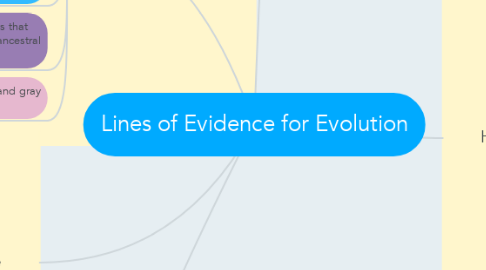Lines of Evidence for Evolution
by Margaret Quick

1. Fossil Evidence
1.1. Example: Shark tooth and "tongue stones"-Nicholas Steno
1.2. Examples: Dinosaur tooth of Iguanadon, not the common iguana we know today-Mary Ann Manteli
1.3. Fossils represent forms of extinct life
1.4. Old rocks have bite marks that are believed to have come from dinosaurs: physical evidence
1.5. Studies of cells in fossils show similarities and differences of past organisms and present organisms
1.6. Transitional forms are fossils/organisms that show intermediate states between an ancestral form and that of its descendants
1.7. Example: Palcicetus, aetiocetus, and gray whale
2. Homologies
2.1. Similar characteristics due to relatedness are known as homologies
2.2. Comparing anatomies of living things, looking at cellular similarities/differences, studying embryological development, and studying vestigial structures in individual organisms
2.3. Example: frogs, birds, rabbits, and lizards all have different forelimbs but have same set of bones
2.4. Example: Hoatzin chicks have claws on their wings, as do some chickens and ostriches. Therefore, bird ancestors had clawed hands
2.5. During some stages of development, organisms exhibit ancestral features in whole or incomplete form
2.6. All life shares common ancestor (cellular level evidence)
3. Distribution in Time and Space
3.1. Relative dating places fossils in a temporal sequence by noting their positions in layers of rocks
3.2. Studying this figures out the order of organisms
3.3. Numerical dating relies on decay of radioactive elements such as uranium, potassium, and carbon
3.4. Distribution of livings things across the globe provides information about the past histories of both living things and the surface of the Earth
4. Evidence by Example
4.1. Artificial selection provides a model that helps us understand natural selection
4.2. Selection has profound effects on populations and has the ability to modify forms and behaviors of living things
4.3. Populations evolve in response to their surroundings
4.4. Experiments provide evidence of evolution; fish became duller-colored after being faced with predators who looked for brighter colors
4.5. Evolution predicts that living things will be related to one another in nested hierarchies
5. Maggie Quick


